The Galapagos Islands are a bucket-list destination for many, offering unparalleled wildlife encounters and breathtaking landscapes. However, choosing the right time to visit can significantly enhance your experience. Whether you’re a snorkeling enthusiast, a passionate photographer, or someone eager to witness the unique wildlife of the islands, this guide will help you plan the perfect trip by breaking down the best times to visit based on seasonal changes, wildlife activity, and personal preferences.
Understanding the Galapagos Climate
Equatorial Location and the Currents around the Galapagos Islands
The Galapagos Islands, positioned right on the equator, enjoy a unique climate that is both mild and varied throughout the year. Unlike many other tropical destinations, where temperatures remain consistently warm, the Galapagos experience noticeable seasonal shifts due to the influence of powerful ocean currents and winds. These natural forces are the primary drivers of the islands’ two distinct seasons: the warm/wet season and the cool/dry season.
The Influential Ocean Currents
The Humboldt Current:
The Humboldt Current, also known as the Peru Current, is a cold oceanic current that flows northward along the west coast of South America before veering westward towards the Galapagos Islands. This current is especially dominant during the cool/dry season (June to November), bringing cold, nutrient-rich waters to the region.
As the Humboldt Current reaches the Galapagos, it cools the surrounding air and lowers sea temperatures, creating a refreshing climate that contrasts with the typical equatorial heat. The influx of nutrients supports a thriving marine ecosystem, attracting a variety of fish, seabirds, and larger marine predators like sharks and whales.
This current also contributes to the phenomenon known as “garúa”—a persistent mist or drizzle that often blankets the highlands of the larger islands during this season, adding to the cooler and more subdued atmosphere.
The Cromwell Current:
The Cromwell Current, an underwater current, flows from the west and rises near the Galapagos Islands. It brings cold, nutrient-dense waters from the depths of the Pacific Ocean to the surface, particularly around the western islands like Isabela and Fernandina.The upwelling caused by the Cromwell Current is crucial for the abundant marine life found in the Galapagos. The cooler, nutrient-rich waters fuel the growth of plankton, which in turn supports a rich food chain, making the region a prime location for observing diverse marine species, including penguins, sea lions, and various types of fish
The Panama Current:
During the warm/wet season (December to May), the Panama Current, a warm oceanic current, flows southward from the tropics. This current brings warmer waters to the Galapagos, raising sea temperatures and altering the climate.
The arrival of the Panama Current leads to warmer air and sea temperatures, often accompanied by more frequent and intense rain showers. The warmer waters make snorkeling and swimming more comfortable, and the islands’ vegetation flourishes, turning the landscapes green and vibrant. This season is also when many species, including sea turtles and land birds, engage in breeding and nesting activities, making it a lively time for wildlife observations.
The Role of Winds
The Southeast Trade Winds:
The southeast trade winds are a consistent and steady wind pattern that blows across the Pacific Ocean from southeast to northwest. These winds are more prominent during the cool/dry season, helping to drive the Humboldt Current towards the Galapagos.
The trade winds also contribute to the upwelling process, where deeper, colder waters are brought to the surface, enhancing marine productivity. Additionally, these winds play a role in shaping the islands’ weather patterns, often bringing cooler, drier air and the characteristic garúa mist to the highlands.
- The Intertropical Convergence Zone (ITCZ):
The ITCZ is a belt of low pressure near the equator where the trade winds from both the northern and southern hemispheres converge. This zone shifts north and south throughout the year, influencing the weather in the Galapagos.
During the warm/wet season, the ITCZ moves southward, bringing with it more humid and unstable air masses. This shift leads to increased rainfall and thunderstorms in the region, contributing to the lush, green landscapes and warmer temperatures typical of this time of year.
Seasonal Transitions
The interplay between these currents and winds creates a dynamic environment in the Galapagos, with each season offering a distinct experience:
- Warm/Wet Season (December to May):
The Panama Current dominates, bringing warmer waters and air temperatures. Rain showers nourish the islands, and the abundant vegetation creates a vibrant landscape. This is a time of life and growth, with many species breeding and nesting. The warmer sea temperatures make it ideal for snorkeling and enjoying the underwater world. Note that even though it is the rainy season, the sky will be less overcast than during the Dry Season. Cool/Dry Season (June to November):
The Humboldt and Cromwell Currents bring cooler, nutrient-rich waters, leading to a bloom in marine life. The trade winds drive these currents and contribute to the cooler, drier air on the islands. The seas are teeming with activity, making it a prime time for diving and observing the rich marine ecosystems. This is also the perfect timing for hikes on the Sierra Negra Volcano, even though the sky might seem cloudy from town.
Month-by-Month Breakdown
Weather, Wildlife and What Awaits
Galapagos in January
Overall
January feels like summer with sunny days and tropical nights. Right now is high season, book in advance!
Water Temperature
The ocean is pleasantly warm at about 75-77°F (24-25°C), ideal for snorkeling and diving.
Air Temperature
Daytime Highs: 80-85°F (27-29°C) Nighttime Lows: 70°F (21°C)
Rain Fall
Light rain showers are common, but they are usually brief and do not interfere much with outdoor activities.
Wildlife in January
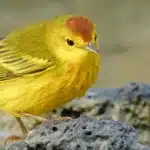
Landbirds
January is the nesting season for the famous Darwin Finches, the bright Yellow Warbler and other landbirds. Keep an eye out for their nests in the lowlands and highlands of all the Galapagos Islands.
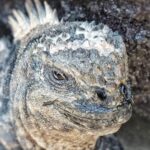
Marine Iguanas
January marks the start of the Marine Iguana mating season. These unique reptiles begin their elaborate courtship displays, with males showing off vibrant colors. The most vibrant Iguanas can be spot on Española Island.

Hammerhead Sharks
Even though ou can find these giants all year around, the biggest gatherings are happening in January. This is also the best time to have calm ocean waters. The best places to see them are Darwin & Wolf, Gordon Rocks, Kicker Rock, Tortuga Island & Devils Crown.
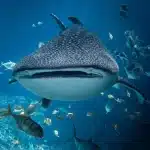
Whale Sharks
January is a prime month to spot Whale Sharks as they pass by the Tortuga Islands. These gentle giants migrate through the area, offering a rare and awe-inspiring sight for snorkelers.

Giant Tortoises
Giant Tortoises are most active in their breeding season from January to May. However, you can observe these ancient creatures year-round at the three different breeding centers in the Galapagos, including those on Santa Cruz, San Cristobal and Isabela.

Land Iguanas
Land Iguanas begin their breeding season in January on Isabela and South Plaza Islands. After around 100 days of incubation, the eggs hatch, bringing a new generation of these remarkable reptiles into the world.
Weather, Wildlife and What Awaits
Galapagos in February
Overall
The days reach peak temperatures. Make sure to drink sufficient and protect yourself from the UV rays. Right now is high season, book in advance!
Water Temperature
The ocean reaches it's peak warmthat about 76-78°F (24-26°C), ideal for extended swims.
Air Temperature
Daytime Highs: 80-85°F (27-29°C) Nighttime Lows: 70-72°F (21-22°C)
Rain Fall
Rain showers get more intense, but they are usually brief and do bring a short cool down.
Wildlife in February
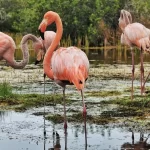
Flamingos
February marks the start of the nesting season for the striking Galapagos Flamingos. These graceful birds can be seen building their nests in the shallow lagoons, particularly on Isabela and Floreana Islands.

Marine Sea Turtles
February is the peak of the nesting season for Green Sea Turtles. Early morning and night are the best times to spot these incredible creatures coming ashore to lay their eggs, especially on the beaches of Isabela and Floreana Islands.

Galapagos Penguins
As the waters warm in February, the Galapagos Penguins retreat from the central islands to the cooler shores of Isabela, Fernandina and a few on Bartolome. Spotting them here is a special treat, as they gather in these more temperate waters.

Nazca Boobies
February signals the end of the nesting season for Nazca Boobies. By now, the skies are filled with juveniles learning to fly, especially around Española Island, where they are most abundant.

Galapagos Dove
The colorful Galapagos Dove begins its nesting season in February. These doves, with their vibrant plumage, can be seen busy at work, especially in the drier areas of the islands like the Bucanero Cove (Sntiago), Sierra Negra Volcano (Isabela) and Punta Suarez (Española).
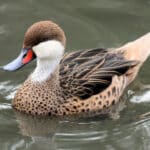
Pintail Ducks
February is the start of the breeding season for Pintail Ducks. These elegant waterfowl are often seen in pairs, preparing their nests near freshwater ponds and lagoons, particularly on Santa Cruz & Isabela.
Weather, Wildlife and What Awaits
Galapagos in March
Overall
The days reach peak temperatures. Make sure to drink sufficient and protect yourself from the UV rays. Right now is high season, book in advance!
Water Temperature
The ocean reaches it's peak warmthat about 76-78°F (24-26°C), ideal for extended swims.
Air Temperature
Daytime Highs: 80-85°F (27-29°C) Nighttime Lows: 70-72°F (21-22°C)
Rain Fall
Rain showers get more intense, but they are usually brief and do bring a short cool down.
Wildlife in March
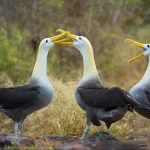
Waved Albatross
March marks the return of the first Waved Albatrosses to Española Island. These magnificent birds, known for their elaborate courtship dances, begin arriving to start their breeding season. Punta Suárez is the best place to witness this incredible spectacle.

Flamingos
March is an exciting time as Flamingo chicks begin to hatch. The fluffy, gray chicks can be seen sticking close to their parents in the shallow lagoons of Isabela and Cormorant Point (Floreana), offering a heartwarming sight for visitors.

Marine Iguanas
Marine Iguana mothers are busy digging nests in sandy areas across the islands. Some nesting sites might even be temporarily closed by the Galapagos National Park to protect these vulnerable nests. One of the best place to spot them is Tintoreras Islet.
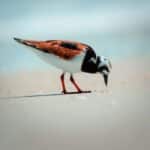
Migratory Shore Birds
As March comes to an end, most migratory shorebirds prepare to leave the Galapagos, heading north for the warmer and longer days of the Northern Hemisphere.
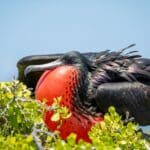
Frigatebirds
Now is a great time to witness the dramatic courtship displays of Frigatebirds, with males inflating their bright red throat pouches. North Seymour, Tortuga and Genovesa Islands are prime spots to see these magnificent displays. While Frigatebirds are opportunistic breeders and can mate year-round when food is plentiful, March often sees a peak in these behaviors.
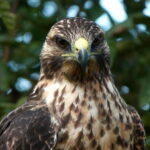
Galapagos Hawks
In March the Galapagos Hawk, the apex predator of the islands, is often seen in pairs as they begin their mating season. They can be spotted soaring above the islands or perched on high branches, particularly on Santiago, Española and Isabela Islands.
Weather, Wildlife and What Awaits
Galapagos in April
Overall
April is a Transition Month. Conditions are phonemenal with nice weather and less visitors.
Water Temperature
The ocean reaches it's peak warmthat about 76-78°F (24-26°C), ideal for extended swims.
Air Temperature
Daytime Highs: 77-82°F (25-28°C) Nighttime Lows: 65°F (18°C)
Rain Fall
Light rain showers happen occasionally, but they are usually brief and do not interfere with outdoor activities.
Wildlife in April

Waved Albatross
April is a prime time to witness the extraordinary mating dances of the Waved Albatross on Española Island. These rare birds perform elaborate courtship rituals, making Punta Suárez the place to be for bird enthusiasts.

Blue-footed Boobies
April marks the start of the Blue-footed Booby’s mating season. Their comical and endearing dances, where they showcase their vibrant blue feet, are a must-see for anyone visiting the Galapagos. North Seymour and Los Tuneles are excellent spots to catch this behavior.

Land Iguanas
On Isabela Island, April is the time when Land Iguana babies start hatching after around 100 days of incubation. These tiny iguanas emerge from their sandy nests, beginning their journey in the arid zones of the island. The best chances to see them is at Cartago Bay.

Green Sea Turtles
April marks the beginning of the Pacific Green Sea Turtle hatching season, which continues through June. Early mornings and nights are the best times to witness these tiny turtles making their way to the sea, especially on the beaches of Isabela, Tortuga Bay and Floreana Islands.

Brown Pelicans
Brown Pelicans begin their nesting season in April, which lasts until May. You can spot these large birds building their nests in coastal mangroves and rocky shores, particularly at Tintoreras. The adults can easily be distinguished from their juvenile counterparts by their white (yellowish during breeding season) neck.
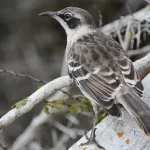
Mockingbrids
While typically shy, the Mockingbirds on Española Island have adapted to the presence of visitors. Some have even learned to open water bottles in their quest for hydration, offering a fascinating glimpse into their clever behavior. You might encounter these resourceful birds at Punta Suárez, where they’ve become quite accustomed to human visitors.
Weather, Wildlife and What Awaits
Galapagos in May
Overall
May is a Transition Month. Conditions are phonemenal with nice weather and less visitors.
Water Temperature
The ocean reaches it's peak warmthat about 76-78°F (24-26°C), ideal for extended swims.
Air Temperature
Daytime Highs: 75-80°F (24-27°C) Nighttime Lows: 60-65°F (16-18°C)
Rain Fall
Rain showers become less frequent. May is one of the most consistent months when it comes to weather.
Wildlife in May

Marine Iguanas
In May, Marine Iguana babies are hatching all over the Galapagos Islands. As they emerge from their nests, these tiny iguanas face immediate threats from predators like Galapagos snakes, hawks, and great blue herons. The dramatic chase between predator and prey is a captivating scene to witness.
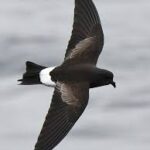
Storm Petrels
May marks the beginning of the first nesting season for Storm Petrels. These small, graceful seabirds are known for their fluttering flight over the waves, and they nest in crevices or burrows across the islands, especially on Genovesa Island.
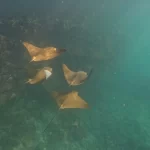
Golden Rays
From December until May, the calm waters of the Galapagos offer the best chances to see large schools of Golden Rays during boat navigation. These elegant rays glide through the waters in mesmerizing formations, a sight not to be missed.
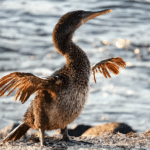
Flightless Cormorants
The Flightless Cormorants start their unique mating season in May, which lasts until October. These birds, found only in the Galapagos, engage in fascinating courtship displays. Chicks hatch after 35 to 40 days, and you can often spot these remarkable birds on the rocky shores of Isabela and Fernandina Islands.
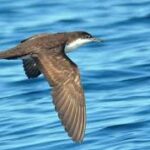
Galapagos Shearwaters
This little bird starts its breeding season from May to October. They are nest in burrows on the Islands. and are monogamous for a lifetime. These pairs engage in elaborate courtship displays, including calling, bill-touching, and sky-pointing.
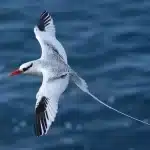
Red-billed Tropicbirds
The Red-billed Tropicbird’s breeding season typically peaks from March to June. During this time, these elegant birds perform dramatic aerial courtship displays, with acrobatic maneuvers and calling to attract mates. They usually lay their eggs in crevices or on cliff ledges, with Genovesa South Plazas and Tortuga Islet being prime locations to observe them.
Weather, Wildlife and What Awaits
Galapagos in June
Overall
June is the first month of the cold season, with still calm waters. It is the calm before the storm as summer vacations have not yet begun in the Northern Hemisphere.
Water Temperature
The ocean starts to cool down 72-74°F (22-23°C). A Short Wetsuit is recommended.
Air Temperature
Daytime Highs: 70-75°F (21-24°C) Nighttime Lows: 60°F (16°C)
Rain Fall
Rain showers become infrequent. Days might start and end misty. The highlands start to dry.
Wildlife in June
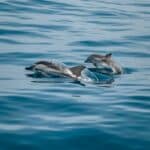
Whales & Dolphins
June is the time when the first whales and dolphins start to appear off the west coast of Isabela Island. This is a prime opportunity for visitors to spot these majestic creatures as they begin their migration through the rich waters of the Galapagos.

Giant Tortoises
In June, wild tortoises on Santa Cruz Island descend from the highlands to the lowlands to start their nesting season. Visitors to the island may witness these ancient giants as they prepare to lay their eggs in the sandy soils of the lowland areas.

Land Iguanas
In June, the Land Iguanas of Fernandina Island kick off their mating season. These striking reptiles engage in competitive rituals as they vie for mates. Later in the year, Land Iguanas on Santa Cruz will follow suit in September, while the Santa Fé Land Iguanas have already completed their mating season, which occurred from February to March.
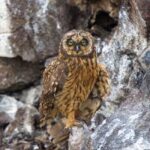
Short Eared Owel
June marks the beginning of the mating season for the elusive Short-eared Owl on Genovesa Island. These owls, often seen hunting during the day, become more active as they establish territories and prepare for breeding.

Blue-footed Boobies
As the Blue-footed Booby’s mating season draws to a close in June, the first eggs and chicks start to appear. This is an exciting time to observe the new generation of these iconic birds, particularly on North Seymour and Española Islands.

Magnificent Frigatebirds
The male Magnificent Frigatebirds on North Seymour Island begin to flaunt their bright red throat pouches to attract mates. These dramatic displays, with males inflating their pouches and calling out to potential partners, are a highlight of the Galapagos wildlife experience.
Weather, Wildlife and What Awaits
Galapagos in July
Overall
During July you have the best chances to spot the first Whales passing the Galapagos. It is high season, as summer vacation started in the Northern Hemisphere. Book in advance!
Water Temperature
The ocean is getting cold 70-72°F (21-22°C). A Long Wetsuit is recommended/necessary.
Air Temperature
Daytime Highs: 68-73°F (20-23°C) Nighttime Lows: 60°F (16°C)
Rain Fall
Days might start and end misty. The highlands are getting dry.
Wildlife in July

Blue-footed Boobies
July is an excellent month to observe the full cycle of nesting in Blue-footed Boobies. You can spot eggs, chicks, juveniles, and subadults all in one visit, especially on North Seymour, los Tuneles and Española Islands. This is a unique opportunity to witness the life stages of these charismatic birds.

Lava Lizards
Lava Lizards across the Galapagos Islands initiate their mating rituals in July, continuing until November. These agile reptiles can be seen performing push-up displays and other behaviors to attract mates, particularly on the sun-drenched rocks of Santa Cruz and Española Islands.

Flightless Cormorantes
July is a significant breeding time for flightless cormorants, especially on Fernandina and Isabela Islands. You might see them building nests and rearing young. Mothers are not very attentive and leave it up to the dad to raise the chicks.

Oystercatchers
The shores of Puerto Egas on Santiago Island are prime nesting grounds for Oystercatchers in July. These striking shorebirds can be seen tending to their nests along the rocky coastlines, providing a great viewing opportunity for bird watchers.

Waved Albatross
July is the best time to see Waved Albatross chicks on Española Island. The young birds are growing quickly, and visitors can observe them being fed by their parents in the breeding colonies at Punta Suárez.
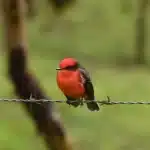
Vermilion Flycatcher
July is a great time to spot the vibrant Vermilion Flycatcher on the Sierra Negra Volcano on Isabela Island. As the paths dry out, the juvenile birds become especially curious and easier to spot, flitting through the trees with their striking red plumage.
Weather, Wildlife and What Awaits
Galapagos in August
Overall
During August big migrating species are passing the Galapagos Island, securing unforgettable experiences. Tourist masses are going down.
Water Temperature
The ocean is refreshing with lots of animals 70-72°F (21-22°C). A Long Wetsuit is necessary.
Air Temperature
Daytime Highs: 65-70°F (18-21°C) Nighttime Lows: 60°F (16°C)
Rain Fall
Days might start and end misty. The highlands are dry.
Wildlife in August

Sea Lion
August marks the start of the birthing season for Galapagos Sea Lions, which continues until December. Newborn pups can be seen along the beaches, particularly on San Cristobal, as they begin to explore their surroundings under the watchful eyes of their mothers.

Flamingos
Flamingos, primarily found on Floreana, Rabida, and Isabela Islands, begin their vibrant mating rituals in August. These elegant birds engage in synchronized displays, adding a splash of color to the Galapagos’ saltwater lagoons.

Galapagos Hawks
The powerful Galapagos Hawks start their courtship in August, with the best viewing opportunities on Española, Santiago and the Sierra Negra Volcano. These apex predators can be seen performing aerial displays and calling to attract mates, marking the beginning of their breeding season.

Swallow-tailed Gulls
Swallow-tailed Gulls, known for their striking red eyes and their unique nocturnal hunting habits, begin nesting in August. You can spot these gulls on Genovesa and Tortuga Islet, where they lay eggs and raise their chicks in the rocky cliffs.

Migratory Shore Birds
August sees the return of the first migrant shorebirds to the Galapagos, with species like Whimbrels, Ruddy Turnstones, and Wandering Tattlers arriving for the season. These birds will stay on the islands until March, utilizing the rich coastal feeding grounds.

Giant Tortoises
After nesting in the lowlands, Giant Tortoises return to the highlands of Santa Cruz Island in August. This migration back to the cooler, more vegetated highlands is essential for their survival during the warmer months.
Weather, Wildlife and What Awaits
Galapagos in September
Overall
During August big migrating species are passing the Galapagos Island, securing unforgettable experiences. Tourist masses are going down.
Water Temperature
The ocean is refreshing with lots of animals 70-72°F (21-22°C). A Long Wetsuit is necessary.
Air Temperature
Daytime Highs: 65-70°F (18-21°C) Nighttime Lows: 60°F (16°C)
Rain Fall
Days might start and end misty. The highlands are dry.
Wildlife in September

Waved Albatross
September marks the time when the majority of Waved Albatrosses leave Española Island. After months of breeding and raising their young, these magnificent birds take to the skies, embarking on their long journey across the Pacific.

Land Iguanas
September is the preferred mating time for Land Iguanas on Santa Cruz Island. During this month, males can be seen vying for the attention of females, engaging in displays of dominance that are a key part of their mating rituals.
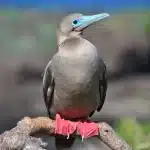
Red-footed Boobies
As the mating season comes to an end in September, the best chances to witness the famous Sula Sula dance are at Punta Pitt and Genovesa. However, like all their cousins, Red-footed Boobies are opportunistic and will continue to have chicks whenever food is abundant.

Humpback Whales
By the end of September, the last of the Humpback Whale mothers are leaving the warm, safe waters of the Galapagos Marine Reserve with their newborn calves. This marks the end of the whale-watching season in the archipelago.

Galapagos Penguins
September is the prime season for Galapagos Penguins to mate. These resilient birds mate whenever food is plentiful, and in recent years, they’ve been observed attempting to mate multiple times a year until they successfully raise a chick.
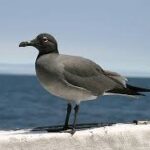
Lava Gulls
The breeding season for Lava Gulls slowly comes to an end in September. Although it’s rare to see very young Lava Gulls, you can later identify the year’s offspring by the untagged individuals. Since the population of Lava Gulls is minimal, each one is tagged. The best chance to spot these rare birds is along the shorelines of Isabela Island.
Weather, Wildlife and What Awaits
Galapagos in October
Overall
During August big migrating species are passing the Galapagos Island, securing unforgettable experiences. Tourist masses are going down.
Water Temperature
The ocean is refreshing with lots of animals 70-72°F (21-22°C). A Long Wetsuit is necessary.
Air Temperature
Daytime Highs: 65-70°F (18-21°C) Nighttime Lows: 60°F (16°C)
Rain Fall
Days might start and end misty. The highlands are dry.
Wildlife in October

Lava Herons
October marks the start of the nesting season for Lava Herons, which continues through March. These small, elusive birds can be spotted building nests in the mangroves and coastal areas.
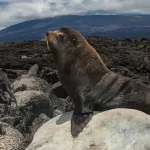
Galapagos Fur Seals
The mating period for Galapagos Fur Seals begins in October and lasts until December. These playful mammals can be seen on the rocky shores of the Fernandina, Isabela, James Bay (Santiago) and Darwin Bay (Genovesa) engaging in courtship behaviors and defending their territories.

Giant Tortoises
In October, Giant Tortoises on Santa Cruz Island begin laying their eggs, a process that continues through November. Visitors to the highlands may witness these ancient creatures as they dig nests and carefully bury their eggs in the soft volcanic soil.

Hammerhead Sharks
October is an excellent time for diving around Darwin and Wolf Islands, where large schools of hammerhead sharks are often seen. These apex predators gather in impressive numbers, providing an unforgettable experience for divers.

Galapagos Penguin
If you’ve always wanted to swim with Galapagos Penguins, October is the perfect time. The waters are teeming with fish, increasing the likelihood of encountering these charming birds as they hunt and play in the ocean, particularly around Tintoreras, Tuneles, the Chinese Hat and Bartolome and Fernandina Island.
Weather, Wildlife and What Awaits
Galapagos in November
Overall
During August big migrating species are passing the Galapagos Island, securing unforgettable experiences. Tourist masses are going down.
Water Temperature
The ocean is refreshing with lots of animals 70-72°F (21-22°C). A Long Wetsuit is necessary.
Air Temperature
Daytime Highs: 65-70°F (18-21°C) Nighttime Lows: 60°F (16°C)
Rain Fall
Days might start and end misty. The highlands are dry.
Wildlife in November

Storm Petrels

Brown Noddies

Sea Lions

Green Sea Turtles

Whale Sharks
Whale sharks are most commonly sighted at Darwin and Wolf between June and November. This period coincides with the cooler, nutrient-rich waters brought by the Humboldt and Cromwell currents, which attract a variety of marine life, including whale sharks.
Weather, Wildlife and What Awaits
Galapagos in December
Overall
During August big migrating species are passing the Galapagos Island, securing unforgettable experiences. Tourist masses are going down.
Water Temperature
The ocean is refreshing with lots of animals 70-72°F (21-22°C). A Long Wetsuit is necessary.
Air Temperature
Daytime Highs: 65-70°F (18-21°C) Nighttime Lows: 60°F (16°C)
Rain Fall
Days might start and end misty. The highlands are dry.
Wildlife in December

Manta Rays

Giant Tortoises
December marks the beginning of the hatching season for Giant Tortoise eggs, which continues until May. During this time, you might witness the first baby tortoises emerging from their nests.

Green Sea Turtles
Green Sea Turtles are in the midst of their mating season in December. Females can frequently be seen basking in the sun on the beaches, preparing for the months ahead when they will lay their eggs.
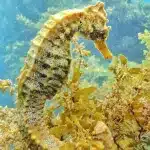
Pacific Seahorses
The warm season from December to March is the prime time for the Pacific Sea Horse’s mating season. These tiny, elusive creatures can be spotted in shallow waters, especially around coral reefs and seagrass beds exclusively at Tuneles and Roca Vincente.

Nazca Boobies
December is a prime time for seeing Nazca Boobies nesting, particularly on Española, Punta Pitt and Genovesa. These large seabirds can be observed tending to their eggs and chicks, offering a close-up view of their fascinating breeding behaviors.
Choosing the Best Time Based on your Needs
The Galapagos Islands are a year-round destination, each season offering its own unique experiences. However, timing your visit based on your specific interests can significantly enhance your trip. Whether you’re a snorkeler eager to explore vibrant coral reefs, a diver seeking encounters with giant marine life, or a wildlife enthusiast hoping to witness extraordinary animal behaviors, choosing the right time to visit can make all the difference. Here’s how to plan your trip based on your personal preferences:
Snorkeling & Swimming (December to May)
If your main goal is to explore the underwater world, the warm season is the best time to visit. The water is warmer and calmer, making it perfect for snorkeling and swimming with sea lions, turtles, and tropical fish. The clear visibility and abundant marine life make every snorkeling excursion a memorable adventure. You’ll also have the chance to swim alongside manta rays and potentially spot playful Galapagos penguins darting through the water.
Diving (June to November)
For diving enthusiasts, the cool season offers the most thrilling experiences. The nutrient-rich waters attract large marine species, including hammerhead sharks, manta rays, and whale sharks. The cooler water temperatures and active currents provide a dynamic underwater environment, ideal for encountering these majestic creatures. If you’re interested in seeing large schools of fish and experiencing some of the best drift dives, this is the time to visit.
Wildlife Viewing (Year-Round)
The Galapagos Islands offer unparalleled wildlife viewing opportunities year-round. However, certain species and behaviors are more prominent in specific months. For example, the blue-footed booby mating dance is best seen in May, while giant tortoises lay their eggs in January. If you’re hoping to see waved albatrosses, visit between April and December when they are present on Española Island. Plan your visit around the species or events you’re most interested in to make the most of your trip.
Photography (October and November)
October and November offer unique opportunities for photographers. The mix of changing seasons brings diverse wildlife activity, and the lighting during these months is ideal for capturing the islands’ stunning landscapes and vibrant wildlife. Whether you’re focusing on underwater photography or capturing the islands’ dramatic volcanic terrain, these months provide the perfect conditions. You’ll also find fewer tourists, allowing for more serene and uninterrupted shots.
Camping (August to December)
If you enjoy being immersed in nature, consider camping in the Galapagos from August to December. The cooler, drier weather is ideal for sleeping under the stars and waking up to the sounds of the islands’ unique wildlife. Camping allows for a more intimate connection with the environment, and you’ll have the chance to experience the islands in a way that few others do.
Crowds & Seasons
The Galapagos is a popular destination year-round, but certain times of the year can be busier. If you prefer a quieter experience, consider visiting during the transition months (April/May and September/October) when the islands are still teeming with wildlife, get the best of both world and there may be fewer visitors.
Ocean Conditions & Seasickness (June to November vs. December to May)
Just like the Galapagos seasons, ocean conditions are heavily influenced by ocean currents. The cooler season from June to November, with increased trade winds, brings choppier seas, which can cause motion sickness, particularly during open water crossings between islands. During these months, be prepared for potentially rougher swells, especially if you’re prone to seasickness. On the other hand, the warm season from December to May offers calmer waters, making it the better choice for those sensitive to motion.
Conclusion
Visiting the Galapagos Islands is a once-in-a-lifetime experience, and understanding the nuances of its climate, wildlife patterns, and seasonal changes can help you make the most of your journey. By familiarizing yourself with the two distinct seasons, you’ll be better equipped to choose the right time to visit, ensuring that your trip aligns with your interests—whether that’s snorkeling in warm, clear waters, diving with majestic marine creatures, or witnessing the unique mating rituals of the islands’ iconic species.
The month-by-month breakdown provides a detailed guide to what you can expect in terms of weather, wildlife activity, and visitor trends, helping you plan each day of your adventure with confidence. Keep in mind that the Galapagos offers something extraordinary year-round, so there’s no wrong time to visit—only the best time for you, based on what you hope to see and do.
By carefully considering your personal preferences, whether it’s avoiding crowds, minimizing seasickness, or timing your visit with specific wildlife events, you can tailor your trip to create the perfect Galapagos experience. No matter when you choose to go, the islands promise unforgettable encounters with nature in one of the most remarkable ecosystems on Earth.